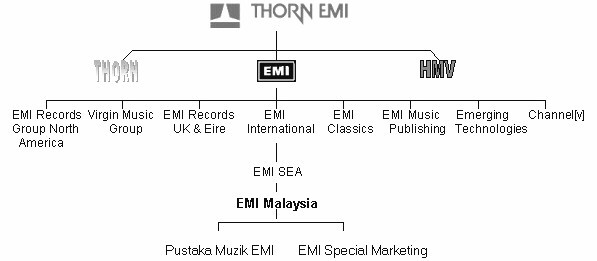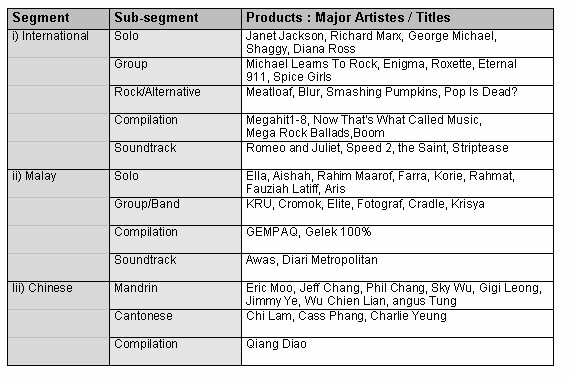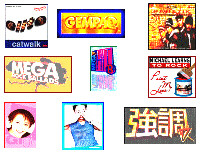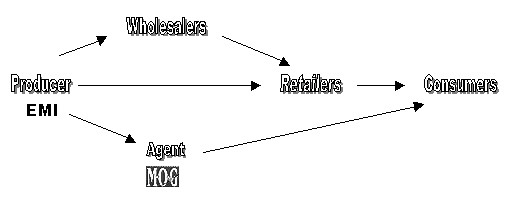

a) EMI Groups
This year, EMI celebrates its anniversary of one century. From the year of 1897 to 1997, the label has established itself in the worldwide record industry.
EMI Music Groups has a total of 65 record companies and 23 music publishing companies in 37 countries. It spans every aspect of the recorded music industry, studio recording, record manufacture, marketing and distribution, and music videos, to the ownership, management and exploitation of music copyrights.
In recent years EMI has strengthened its position in the world record market by acquiring a number of other important record companies, including Chrysalis and Virgin, as well as developing its own roster of outstanding acts. Today EMI is unrivalled both for the richness of its past heritage and for the strength of its current catalogue featuring many of the world’s most successful pop and classical artists.

b) EMI Malaysia
EMI Malaysia was incorporated in 1966. It was the first multinational record company that incorporated in Malaysia. EMI Malaysia’s administration is coordinated under one of the EMI Music Groups’ subsidiaries, EMI International.
Basically, EMI Malaysia is an entertainment company whose principal activities are acquisition, production, marketing and distribution of recorded music. The Company specializes in producing, marketing and distributing local recorded music under the label of EMI. The company also distributes other EMI companies’ products and the associated labels’ products. Being actively involved in the three major language repertoire - English, Malay and Chinese, EMI Malaysia is one of the three top record companies in Malaysia.
EMI Malaysia has two subsidiaries. One of its subsidiaries, Pustaka Muzik EMI (M) Sdn Bhd, is also the first music publishing company established in Malaysia. Today, the company has a total staff of seventy, consisting of a team of young and older professionals, combining enthusiasm with experience, youth with maturity and aggressiveness with creativity.
EMI Malaysia has, since the sixties, led the fight against the record pirates for the infringement of music copyrights. To this end, this organization became a founding member of the Malaysian Association of Phonogram and Videogram Producers and Distributers (MAPV) in 1979, which had been restructured and changed its name to Record Industry of Malaysia (RIM) in 1996.
Over the years, EMI Malaysia has been responsible for the music career of some great local artistes such as P. Ramlee, Saloma, Sudirman and Sharifah Aini. The major artistes who are now directly under contract with EMI Malaysia are the ‘Rock Queen’ Ella, R&B group KRU, Rahmat, Aris Ariwatan, Sharifah Aini, Rahim Maarof, Cromok, Loong Piao Piao, Zhang Zhe, Farra, Krisya, Korie, Mac Ruhayu and Nurade.
3.2 Overview of the Marketing Strategies of EMI Malaysia
The marketing strategies of EMI Malaysia are driven by products and customers’ need. EMI Malaysia believes that the development of talent with potential for mass markets appeal is the key to obtaining market share and profitability. In addition, it believes that the diversity of its music label, repertoire and products helps to absorb the impact of shifts in audience tastes.
A major step taken by EMI Malaysia for the last few years is in the marketing of its Chinese products. EMI Malaysia has also become a competitive player in the Chinese music market, besides the Taiwan based Rock Records. EMI Malaysia also started its very first move in the Islamic nasyid song which has successfully brought profitability to the company. Besides continually attacking the potential markets, EMI Malaysia maintains its efforts in marketing its international English products.
A significant act that supports EMI Malaysia’s marketing strategy is the formation of its new division , EMI Special Marketing (to be incorporated and become an indipendent subsidiary soon) in 1996. This division has successfully taken over the music assets of Happy Records, one of the local Chinese labels. The division is going to focus on the acquisition of products from other local and foreign labels.
The
main functions of EMI Special Marketing are to strengthen the product lines
and to share the projects of EMI Malaysia. The company has developed some
new products including the Indian music, oldies and evergreen in both Chinese
and English, and also some classic series.
The marketing strategies of this division are sales, promotion and
distribution rather than original repertoire development. The subsidiary
is going to enter the market with economic items, and also with other distribution
channels such as television marketing and special counters at hotels and
petrol stations.
EMI Special Marketing is still in the early stage of development. Marketing strategies for the main products of EMI Malaysia are still managed by its established marketing department.
Detail marketing strategies and practices of EMI Malaysia are discussed below.
3.3 Product Line
Recorded music is an entertainment product. The choices of music are different among consumers due to different cultural backgrounds, lifestyles and interests. Generally, EMI Malaysia does not emphases only in a particular kind of music such as popular music, but also tries to develop the markets of all kinds of music.
Basically, the products of EMI Malaysia can be divided into two major groups. The first group is the popular music, which is targeted at the mass market. The second group is the combination of other types of music such as classical, instrumental, oldies and Indian, which is targeted at niche markets.
a) Mass Market Products
Popular music is the most important product group of EMI Malaysia. The products of this segment is shown below:

i) International
This is the most important segment among the product lines. Malaysian speaks English and has a lot of exposure to the western music. International English songs are well accepted and enjoy the biggest market potential in this country. Throughout the years, EMI Malaysia markets its international associated companies’ products through the EMI’s inter-company licensing agreement.
EMI Malaysia’s product covers all kinds of patterns such as Pop, Rock, Rhythm and Blues, Rap, Alternative and Techno-Dance. The “Alternative” music is the latest pattern in the popular music scene, EMI Malaysia has marketed Blur, Smashing Pumpkins, Butterfingers and the compilation series “Pop Is Dead?” for this category. EMI Malaysia has also started its involvement in the dance music recently after the EMI Music Groups acquired some top dance labels in the Europe. More dance albums will be released in the future.
The
best selling items for the first half of 1997 included Michael Learns To
Rock’s album “Paint My Love-Greatest Hits” and the “Megahit 8” compilation
album. Megahit is the company’s yearly compilation album featuring the
best selling hits of the year.

ii) Malay
Different from the other segments, EMI Malaysia is responsible for the album production and artistes development in the Malay segment as it is the company’s own developed products. EMI Malaysia has successfully developed some qualify artistes such as Ella, KRU and Farra. The products are not only limited to the traditional style of Malay pop songs, but also has covered many other new patterns such as Rhythm and Blues and dance music. “GEMPAQ” is the Malay compilation album in “Megahit” concept. “Lagi GEMPAQ” is released after the success of “GEMPAQ”
iii) Chinese
EMI Malaysia started to market its Chinese products aggressively in 1994 when the products from Taiwan and Hong Kong were well developed. Best selling Chinese artistes currently under EMI’s label are Eric Moo, Jeff Chang and Cass Phang. EMI’s Chinese products are enriched with the joining of Faye Wong in May 1997. Faye Wong is the former artiste of Polygram and she is the most popular and the best selling female artiste in Asia.
Following the success of “Megahit”, EMI Malaysia has created a compilation album in Mandarin - “Qiang Diao”, which means “strong tune” in Chinese. EMI has always believed in creating a compilation album with all top current hit songs and top artistes, thus creating a truly value for money album. “Qiang Diao” received very good response where sales figure reached a target of more than 150,000, making it the best selling compilation album in the market. It was voted the number one RIM compilation chart of the year of 1996. Due to this overwhelming result, EMI has released the “Qiang Diao 97”.
b) Niche Market Products
EMI Malaysia markets various kinds of music for the niche market:

i) Evergreen
EMI continually seeks to exploit the rights it has acquired or created. The exploitation of existing products may substantially enhance the company’s profits by the issue of re-releases, "Best of" and compilation albums. Today, EMI Malaysia still markets the original recordings of P. Ramlee, Saloma and Sudirman. These recordings are considered as classic and may have an everlasting market.
In late 1996, EMI Special Marketing division purchased the music assets of Happy Records. Some recordings have been reproduced and re-released in the form of collection and compilation series. For example, Loong Piao Piao’s songs where recorded under Happy Records in the late 70s, is now re-released by EMI Malaysia. All those albums have gone through “digital remastering” which improves the sound quality tremendously.
ii) Instrumental
There are many popular instrumental items marketed by EMI Malaysia. For example, violin played in the modern way by Vanessa May, modern jazz saxophone by Richard Elliot, another violin player Nigel Kennedy and et cetera. For this segment, EMI Malaysia is focusing more on “instrumental in popular way”. A “Hit Melodies” series is released which features some great songs in instrumental. For those serious instrumental music or acoustic music, EMI Malaysia imports directly from its foreign associated companies.
iii) Classical
There are such great products represented by EMI Music. Due to the lack of interest in classical music in this country generally, EMI Malaysia imports and distributes them in small quantities. Nevertheless, EMI Malaysia still markets classical music with tunes that are more familiar and acceptable to the consumers. A series of classical albums were released in 1995 featuring the classical tunes in compilation or collection form. They are “Favorite of Mozart”, “Favorite of Opera”, “Favorite of Beethoven” and etc.
iv) Indian
Indian music is a new segment that EMI Malaysia currently gets in. The company promotes two new Hindi soundtrack albums entitled “Sapnay” and “Virasat”. EMI also has 11 albums of a collection of Hindi and Tamil popular tunes from the 60's and 70's, from artistes like Mohd Rafi, Lata Mangeshkar, Kishore Kumar Mukesh and S.P. Balasubramanyam.
v) Nasyid
Nasyid is the Islamic choral song. For years, this segment has been manipulated by independent label. After the success of Warner Music Malaysia in their choral group Raihan’s album, EMI Malaysia entered this segment by introducing a group called Rabbani. Rabbani brings out traditional nasyid songs which comprises of Tarannum Al-Quran melody songs. The songs maintain classic nasyid elements and are presented in good recording quality.
vi) Poems
EMI Malaysia has come out with another unique release – the “Puisi Kekasih” album. This album compiles 10 poems from more than 5 Sasterawan Negara such as Usman Awang, A. Samad Said, A. Aziz, Deraman, Rahman Shaari, Firdaus Abdullah, Dharmawijaya, A. Rahim Abdullah, Amir Hamzah and Latiff Mohidin. Poems are accompanied with suitable melodies. This album is specially made for the literature enthusiasts, creating another new segment in the record industry of Malaysia.
3.4 Product Features
a) Format
The major formats for EMI Malaysia’s products are the compact disc and cassette tape. As similar to the industry, the percentage of manufacture is 55% for cassette tape and 35% for compact disc. Besides audio products, EMI Malaysia also markets audiovisual product, thus music videos (MTV) and life performance recordings in videocassette (VHS) and video compact disc (VCD) formats. For popular items such as compilation albums, they normally are released in all formats included the laser disc (LD). EMI Malaysia has released the “Megahit”, “Qiang Diao” and “GEMPAQ” in all five different formats.
b) Packaging
The physical packaging of the products can be divided into two parts, one is the album cover and the other is the product case. All album covers of EMI Malaysia are printed by Digitpress Sdn. Bhd.. Artwork and material is emphasized. To differentiate its products from other brands, EMI Malaysia uses the black transparent plastic case. The black transparent case has also enhanced the products’ feature by making them seem more exclusive and qualified. The logo of EMI is shown on both the cover and the case.
3.5 Promotion
Promotion is another important element in the marketing mix. This also applied in the record industry. Sometimes, the success of an artiste depends on the promotion. A product with average quality may become a best selling item if an effective campaign is carried out. On the other hand, a potential product may lose in the market with no appropriate promotional supports. The promotion task of EMI Malaysia is being conducted respectively under three major repertoire departments: International, Malay and Chinese departments. Promotion is developed by a promotion plan with a fixed budget. Normally each new album is being promoted independently. Joint promotion is also applicable. For potential items, EMI Malaysia will try to get the best exposure, using all channels that are accessible.
a) Advertising
Advertising is the main promotion practice for EMI Malaysia. The media being used included print media, broadcast media and window display. For potential product with mass markets appeal, the advertising campaign is conducted in phases. Major press and popular entertainment magazines are chosen to advertise. EMI Malaysia tends to advertise in full or half page to create public awareness and confidence on its product. Music bulletins such as the RIM Chart handout and the Salem Power Hits Chart handout, are also the alternatives for advertising. To advertise through broadcast media, samples are synchronized with informative and persuasive copy. Intensive advertisements may make the consumers familiar with a song and may create a perception like “it is popular and it is a great hit”. Consequently, making it become a demanded item in the market.
Window display is another important media to promote a new album. Normally posters and videos are distributed to retail stores for displaying purpose. To end this task, display corners are rented at major retail stores such as Salem Power Station. In support of the launching of its very first Chinese compilation album “Qiang Diao”, EMI Malaysia has made a nationwide window display campaign in all the music retail stores.
b) Publicity
Publicity is another important promotion tool. Positive comments and reviews from media may enhance the reputation of a newly marketed item. Exclusive listening events and press conferences are being held by EMI Malaysia for the launching of its products. Reporters and representatives of all media such as press, magazines, radio stations and television stations are invited to these functions. Press kits, promotional compact discs and music video sets are delivered to the media. Reports, previews and broadcastings of promotional materials by the media may produce free publicity. Publicity can also be carried out in forms of active participation in interviews and public performances. Music video or artiste appearance through television broadcast such as the RIM Chart Show, is also one kind of publicity. The effectiveness of publicity depends greatly on the efforts of the public relation staffs.
EMI Malaysia also runs some public activities to get publicity. In order to promote the “Qiang Diao 97” album, a very grand karaoke singing contest was held between April to June in 1997. The contest was held at all outlets of Song Bird group throughout Malaysia. A "Feast With The Stars" contest is also being held in April 1997 when ten lucky winners were invited to a hi-tea with the EMI artistes Farra and Zhang Zhe at Musictheque, Istana Hotel.
c) Website Communication
The development of Internet has created so much opportunities for the record industry. Internet is being used by record companies as a promotional tool as well as a communication tool for getting connected with consumers. EMI Malaysia Home Page was launched at 15 May 1996 with the address http://www.jaring.my/music. It was the first Malaysian recording company to go on the Internet with sound. The homepage is constructed and edited by Beta Interactive Services, Cause-Colybrand Consulting Sdn. Bhd. EMI Malaysia Home Page was the winner of the Best Home Page Package Award in The Secondnd Malaysian Video Awards in 1996.
The homepage gives a lot of information about the hot items that are currently being offered by the company. The album charts give a brief idea to the consumer which albums are popular. Consumers can also listen to some song samples through the Internet before they make the buying decision. The musical news, artistes’ pages and photographs may let the consumers to know better about the artistes and their albums. Apart from that, consumers’ participation in the “Vote and Win Contest” and the feedback form may create a friendly connection between the company and consumers. Consequently, it helps the company to know better the audience tastes.
d) Sales Promotion
Normally the sales promotions conducted by EMI Malaysia are concerned with some added value such as posters, gifts, contests opportunities or limited version of value packaging. Sales promotion is never held in the form of discounts.
3.6 Price
As most of the companies in the record industry, EMI Malaysia practices cost-orientated pricing. The manufacturing costs for all product groups are the same, which consist of the disc or cassette, casing and cover printing. Royalty payments for master recording which consist of singer royalties, songs copyright royalties and production royalties will be different among product groups. Due to the acquisition cost of foreign products is higher, this makes the prices of foreign products higher than the local products. Royalty payment is paid on percentage basis upon the retail price.
Besides the cost, price is also affected by the supply and demand of recorded music in the marketplace. Due to the in-elasticity of price of recorded music in the short run, all products never sold in discount. There is no pricing advantage for any company in this industry including EMI Malaysia.
The prices of EMI Malaysia's products are within the range of prices among all multinational record companies in this country. The current suggested retail prices for EMI Malaysia's products is as below:
| Cassettes | CD | |
| International | RM 16.90 | RM42.00 |
| Asia/Local | RM 15.90 | RM39.90 |
3.7 Distribution
The distribution of EMI Malaysia's products is as described in the diagram below:

There are 3 major distribution flows. The first is “producer-retailers-consumers”, the second is “producer-wholesalers-retailers-consumers”, and the third is “producers-agent-consumers”.
a) Multi Level Distribution
The first and the second flows are the main practice of distributions. For independent retailers in town areas or retail chains such as Salem Power Station, goods are delivered to them directly without going through the wholesalers. For small retailers that spread in rural areas, the participation of wholesalers is needed.
There are about 30 sales representatives whose task is to obtain orders from wholesalers and retailers. Orders are taken two weeks before the launch of a new album. Orders of existing products may be made through phone calls and goods will be sent in one week. Goods are delivered directly to the center of chained retailers, the independent retailers and wholesalers by the company's van. For some cases that concern about time limit, courier service will be the alternative.
Generally, the record industry attempts to restrict the return of products that remain unsold. However, the company's returns policy is determined largely by industry practice or legal requirements. EMI Malaysia experiences an annual overall return rate of approximately 15%.
b) Direct Marketing
As shown in the distribution diagram, EMI Malaysia is running a “semi-direct” marketing. EMI Malaysia appoints MOG Sdn. Bhd to be its agent to run the direct marketing. They advertised at http://www.jaring.my/biz/mog/frame.htm, a link from EMI Malaysia’s homepage, with the total of 60 items. Classic albums are the main products that are focused in direct marketing. Out of the sum, 60% is Malay classic albums such as P. Ramlee, Saloma, Sudirman, Sharifah Aini and Shela Majid. Western Classical is 10% which includes great composers like Beethoven, Mozart and Schubert. The rest of 30% consists of Malay popular albums such as KRU and Ella. All the items can be ordered through phone calls or email. Goods are sent by post.